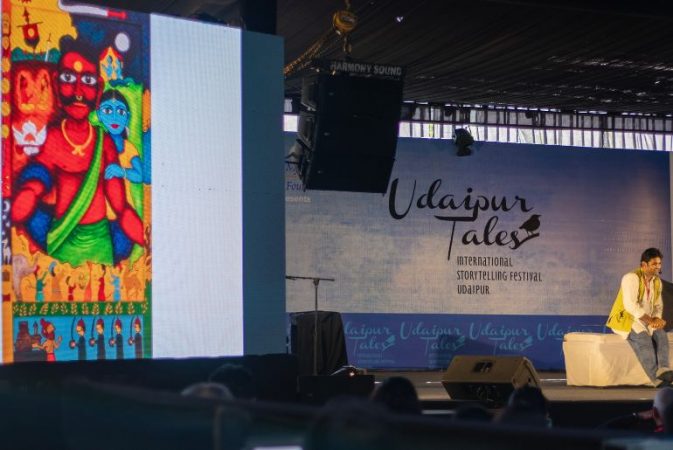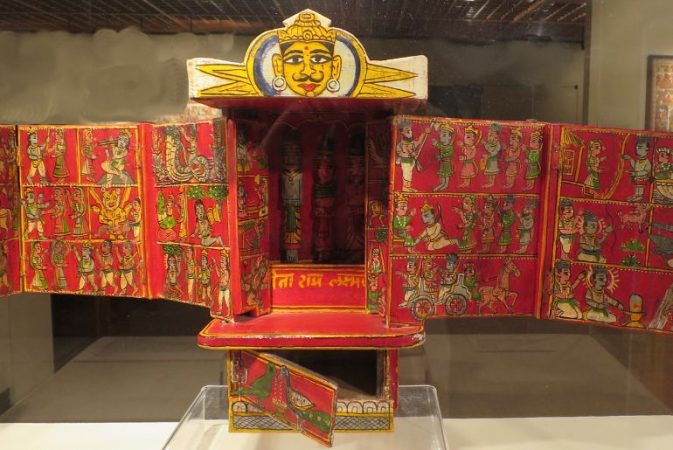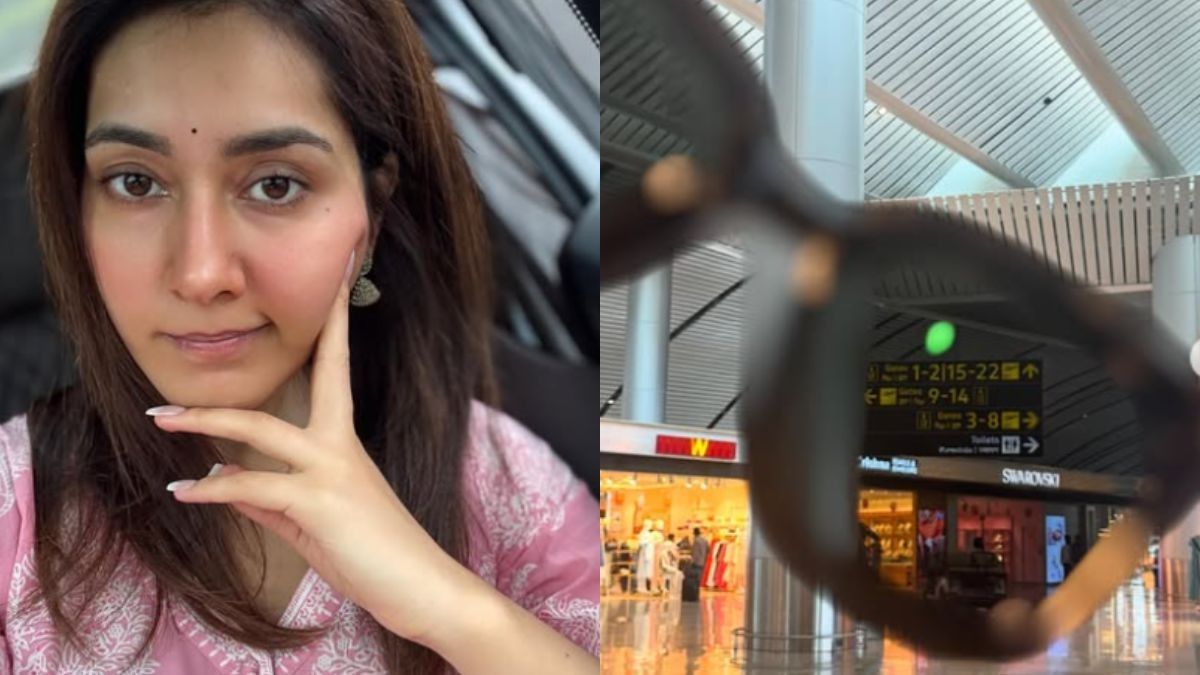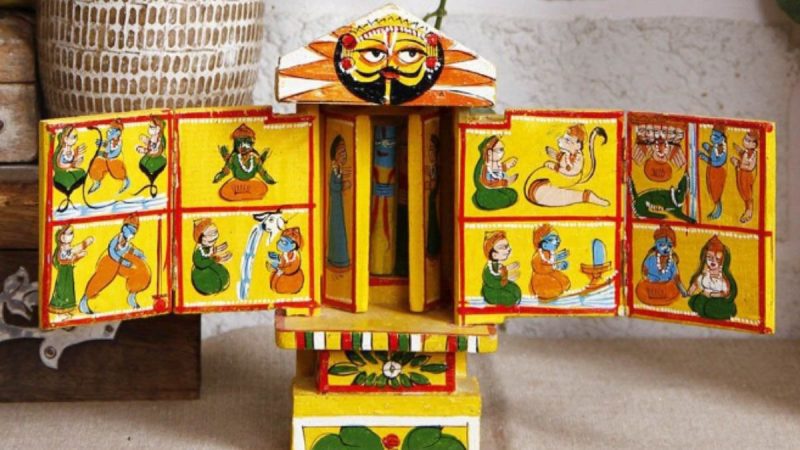In many cultures, storytelling holds a special place of reverence. “When my grandmother tells me stories, she always pauses to highlight a particular wisdom or aspect. For another family, that same story will highlight a different wisdom,” says artist Akhshay Gandhi. Whether shared by wise grandmothers or whispered among children, tales of folklore have a timeless quality. For Gandhi, it was Rajasthan’s Kavad Katha that opened a portal into the intricate narratives, legends, and cultural heritage of the region. You can find certain stories in wooden boxes that resemble cupboards and have several doors. Within the confines of a wooden box, artisans weave tales that span generations.
Storytelling Through A Wooden Box

At the recently concluded fifth edition of the Udaipur Tales International Storytelling Festival, the art of Kavad unfolded in front of me. Akhshay carried a wooden box adorned with intricate motifs and bright colours. As he opened the box, the true magic unfolded. Inside, multiple hinged panels reveal a series of meticulously painted scenes, depicting different stories. I was awestruck as Gandhi brought his theatrical magic, changing his voice modulation and articulation as he narrated folktales, ancient epics and historical events in an interestingly sing-song manner.
When it comes to traditional art forms in Rajasthan, they are as old as time itself. So is the same for Kavad. “These exquisite wooden boxes serve as vessels for tales that have been passed down through oral tradition,” explains Gandhi. “This art form has a sort of folk logic attached to it. So that it does not become about the exact time but rather about that story itself. There are various references to its origin, beginning from fantasy folk tales to how earlier families used to maintain long ancestral family trees. My understanding is that it developed into a narrative over time and ultimately, this led to the Kavad box, which may be as old as 400–500 years.”
At first glance, a Kavad appears as a simple wooden box, perhaps adorned with intricate motifs and bright colours. The stories depicted often reflect cultural ethos and values, celebrating heroism, love, devotion, and the triumph of good over evil. This box is more than just a prop for individuals who perform this art. It is regarded as a shrine. Additionally, there’s an interesting way in which the same picture can narrate different stories. “One of the most intriguing aspects is that, when compared to other visual modes of storytelling in India, the painting portrays what it is. You see, Kavad boxes can be repurposed. It is entirely up to the storyteller to develop an interpretation of the same image. You can repurpose the paintings and tell different tales. Kavad boxes depict enough to tell more than one story,” he highlights.
Beyond Its Aesthetic Appeal
Historically, itinerant storytellers would travel from village to village with their Kavads, regaling audiences with tales of gods, heroes, and mythical beings. These storytellers played a crucial role in preserving and sharing cultural knowledge across generations. The performance of a Kavad Katha is a meticulously choreographed affair; he would narrate the story depicted therein, his voice rising and falling like the cadence of a sacred chant. But, in kavad kathas, the boundaries between performer and audience remain dissolved. What set Kavad Kathas apart from other forms of storytelling was its interactive nature.

The wooden-painted Kavad box requires a great deal of carpentry and artwork. While the exact duration may vary depending on factors like the size and complexity of the box as well as the artisan’s expertise, a typical Kavad can take anywhere from several weeks to several months to complete. “In our situation, we get the cover of the box created by either a carpenter or a cover maker, which normally takes about seven days. Next, we have to conceptualise what we show and convey. Accordingly, we start with the artwork, and that, again, could take between 1-3 weeks. Occasionally, narrations change, and then the painting takes between 10 and 12 days again. Making one Kavad box takes almost one and a half months, from conception to execution,” he shares.
While modern tools and techniques may streamline certain aspects of Kavad making, the essence of the craft remains rooted in centuries-old practices and techniques passed down through generations. But how do you make an age-old tradition relevant that transcends the boundaries of age and time? What can be done to make a mythology-based storytelling practice resonate with contemporary times?
“Most of my stories are original; they’re not from any mythical, tribal or folk tales. They revolve around the contemporary questions and emotions that we deal with in our day-to-day lives. It takes time for me to write and create these stories. First, the visual artist and the artist will start bringing the concept of the story to life: how to represent the characters and bring them to light; the colours, textures, and shapes; how the paintings can be connected; how to ensure thematic cohesion; and more. Artists are, however, free to design and envision whatever they like. As far as the kavad storyteller is concerned, he can continue with what the visual artist intended to depict. This is how my stories are shaped,” he brings to notice.
Nowadays, Kavads are infused with narratives and elements that resonate with modern sensibilities, addressing issues such as identity, diversity, inclusion, and social justice. Gandhi highlights how he met with an NGO at the Udaipur Storytelling Festival that had used Kavad boxes to spread awareness about sex education and sexual health in villages about 20 years ago. By weaving these themes into the fabric of Kavad storytelling, they tend to speak about the hopes, fears, and dreams of today’s youth.

Kavad Katha: A Newfound Recognition?
As I gaze upon these miniature marvels, I realise how the art of Kavad Katha is intricately woven and binds you to listen—the stories came alive, and history was made tangible. In contemporary times, Kavads have found new admirers both within India and across the globe.
“When it comes to Kavad, it’s less scholarly research; it’s more performance research. Given modern times, we like it when the art forms are performed, articulated, and systematised. However, if you talk to the ones who performed earlier or the carpenters, it’s not a concept for them. For us, storytelling brings out the architecture, the art and more. When you start to research from an artist’s point of view, there’s no end to it. We tend to find more meaning and understanding as we create more material around it. As we take the show to more people, they are getting interested and have started doing it in their own spaces,” he highlights.
Also Read: This Eco-Tourism Village In Jharkhand Houses The Revived Art Of Paitkar Painting
Across India and around the world, storytelling festivals like Udaipur Tales, Kathaar Festival, Kahaani and more have emerged as vibrant hubs. They celebrate oral traditions and showcase the enduring power of storytelling. “Once I learned there was a school that used Kavads as a visual medium to educate children about folktales, I even witnessed a Durga puja pandal celebrating this art form. It is evident that the word has spread, and people are taking it in their own ways to celebrate it. However, this is from a more modern urban point of view,” he adds. Moreover, museums, galleries, and cultural institutions are increasingly recognising the importance of this art form as an intangible cultural heritage.

“There’s work happening at multiple levels. However, the matter of concern is regarding the art of Kavad storytelling because that is not much in focus. The box has survived, and the paintings have survived but the storytelling behind them needs to be highlighted. When it comes to this oral tradition of storytelling, there’s a style to it, a form and structure to it. So we still have to figure out how storytelling art can survive and be passed on forward,” Gandhi talks about this underlying challenge. He also adds how virtual exhibitions and animation can add an innovative flair to Kavad.
For now, the resurgence of Kavad has highlighted the value of oral storytelling—which is sometimes undervalued—in promoting creativity, conversation, and interpersonal relationships.
Cover image credits: Facebook/Sita India
For more such snackable content, interesting discoveries and the latest updates on food, travel and experiences in your city, download the Curly Tales App. Download HERE.
First Published: April 12, 2024 5:37 PM




